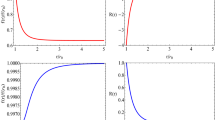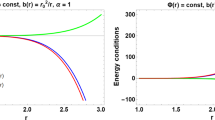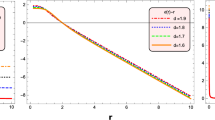Abstract
In this work, we show that any viable f(R) gravity model with constant scalar curvature could be implemented to construct wormholes that are supported by ordinary matter. In particular, the constructed wormholes give rise to attractive geometries at least in specific regions, if the ratio between the Lagrangian density function f(R) and its derivative \(F=\frac{df(R)}{dR}\) satisfies certain constraints. In this context, we derive static, spherically symmetric and traversable wormhole solutions supported by anisotropic matter field where both the weak and the strong energy conditions could be satisfied. The obtained solutions are physically realistic as they respect the asymptotic flatness condition. The case of traceless energy-momentum tensor is further investigated where it is shown that if the Ricci scalar is constant, then the only admitted f(R) gravity model is the one involving a square Lagrangian, i.e \(f(R)=cR^2\). For this model we derived the constraints that allow the corresponding wormhole to satisfy the energy conditions.


Similar content being viewed by others
References
Flam, L.: Bitrage zur Einsteinschen Gravitationstheorie. Phys. Z. 17, 448 (1916)
Einstein, A., Rozen, N.: The particle problem in the general theory of relativity. Phys. Rev. 48, 73–77 (1935)
Morris, M.S., Thorne, K.S.: Am. J. Phys. 56, 395 (1988)
Visser, M.: Lorentzian Wormholes: From Einstein to Hawking. American Institute of Physics, New York (1995)
Bhawal, B., Kar, S.: Phys. Rev. D 46, 2464 (1992)
Nand, K.K., Bhattacharjee, B., Alam, S.M.K., Evans, J.: Phys. Rev. D 57, 823 (1998)
Bohmer, C.G., Harko, T., Lobo, F.S.N.: Phys. Rev. D 85, 044033 (2012)
Furey, N., DeBenedictis, A.: Class. Quantum Gravity 22, 313 (2005)
Banerjee, A., Singh, K., Jasim, M., Rahaman, F.: Traversible Wormholes in \(f(R,T)\) Gravity With Conformal Motions. arXiv:1908.04754v1 [gr-qc] (2019)
Starobinsky, A.A.: Phys. Lett. B 91, 99 (1980)
Capozziello, S., Cardone, V.F., Carloni, S., Troisi, A.: Int. J. Mod. Phys. D 12, 1969 (2003)
Carroll, S.M., Duvvuri, V., Trodden, M., Turner, M.: Phys. Rev. D 70, 043528 (2004)
Nojiri, S., Odintsov, S.D.: Phys. Rev. D 68, 123512 (2003)
Multamaki, T., Vilja, I.: Phys. Rev. D 74, 064022 (2006)
Fjallborg, M.: Class. Quantum Grav. 24(9), 2253–2270 (2007)
Faraoni, V.: \(f(R)\) Gravity: Successes and Challenges. arXiv:0810.2602 [gr-qc] (2008)
Capozziello, S. De Laurentis, M.: Extended Theories of Gravity. arXiv:1108.6266v2 [gr-qc] (2011)
DeBenedictis, A., Horvat, D.: Gen. Relativ. Gravit. 44, 27711 (2012)
Sharif, M., Zahra, Z.: Static wormhole solutions in \(f(R)\) gravity. Astrophys. Sp. Sci. (2013). https://doi.org/10.1007/s10509-013-1545-8
Lobo, F., Oliveira, M.: Wormhole Geometries in \(f(R)\) Modified Theories of Gravity. arXiv:0909.5539v2 [gr-qc] (2009)
Author information
Authors and Affiliations
Corresponding author
Additional information
Publisher's Note
Springer Nature remains neutral with regard to jurisdictional claims in published maps and institutional affiliations.
Appendices
Appendices
Consider the following curvature invariants:
where R is the Ricci scalar, \(R_1\) and \(R_2\) are respectively the first and the second Ricci invariants and \(S_{ij}\) is the trace free Ricci tensor given by \(S_{ij}=R_{ij}-\frac{R}{4}g_{ij}\). The value of the above invariants for the general static wormhole metric (1) are given below
Ricci invariants of the first solution (20)
Recall that \(b(r)=r_0\) and \(\psi (r)=\psi _0\) so the invariants are given by
Ricci invariants of the second solution (27)
In this case, \(b(r)=\frac{r_0^2}{2r_0+1}(2+\frac{1}{r})\) and \(\psi (r)=\ln {\frac{r+1}{r}}\) so the invariants are given by
Ricci invariants of the third solution (37)
In this case, \(b(r)=\frac{r+10r^2+39r^3+71r^4+51.5r^5+(r_0^{-2}+9r_0^{-1}+32r_0+28.5)r^5e^{2/r-2/r_0}}{(1+2r)^5}\) and \(\psi (r)=-\frac{1}{r}\) so the invariants are given by
Rights and permissions
About this article
Cite this article
Al-Ali, U.S., Bokhari, A.H. Constructing wormhole solutions of attractive geometries in the framework of f(R) gravity. Gen Relativ Gravit 54, 2 (2022). https://doi.org/10.1007/s10714-021-02885-1
Received:
Accepted:
Published:
DOI: https://doi.org/10.1007/s10714-021-02885-1




